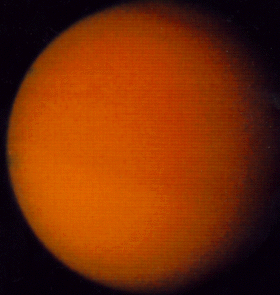
Methane gas shoots out of ground cracks on the Saturn moon
By Rod Thompson
Honolulu Star Bulletin
10-20-05
HILO >> Astronomers using two observatories on Mauna Kea have gained evidence that methane gas shoots out of ground cracks or volcano-like structures on Saturn’s moon Titan, creating clouds and weather on the giant satellite. By Rod Thompson
Honolulu Star Bulletin
10-20-05
Astronomers know there is a lot of methane on Titan, but sunlight should quickly destroy it.
“For a long time, we’ve wondered why there is methane in the atmosphere of Titan at all, and the answer is that is spews out of the surface,” said Michael E. Brown, an astronomy professor at the California Institute of Technology.
“What is tremendously exciting is we can see it from Earth; we see these big clouds coming from above these methane vents or methane volcanoes,” Brown said in a CalTech statement.
Brown, astronomer Henry G. Roe, and others used the Keck Observatory and the Gemini North Observatory during a two-year period to see the methane clouds. Their findings will be published tomorrow in the journal Science.
The astronomers used an unusual viewing schedule. An astronomy team is generally given all night for one or more nights to complete its observations.
The Roe and Brown team was given only “quick looks” of a few minutes on 82 nights over two years. They saw clouds on Titan on only 15 of those nights.
“The clouds usually popped up quickly and generally had disappeared by the next day,” the CalTech statement said.
Some of the clouds were 1,200 miles long on a moon a little less than half the diameter of Earth.
But the clouds were only seen in the middle of Titan’s southern hemisphere, and most originated in one particular spot. Roe and Brown concluded they came from something on the ground, not activity in the atmosphere, which would be more generalized.
Although the Keck and Gemini telescopes have devices to smooth out the effects of ripples in Earth’s atmosphere, they still can’t see how the methane escapes from the ground.
The gas may come from temporary cracks or from “cryovolcanoes,” cold features powered by gas shooting water, ammonia, and other liquids which quickly freeze, CalTech said.
More . . .
Home
No comments :
Post a Comment
Dear Reader/Contributor,
Your input is greatly appreciated, and coveted; however, blatant mis-use of this site's bandwidth will not be tolerated (e.g., SPAM, non-related links, etc).
Additionally, healthy debate is invited; however, ad hominem and or vitriolic attacks will not be published, nor will "anonymous" criticisms. Please keep your arguments/comments to the issues and subject matter of this article and present them with civility and proper decorum. -FW